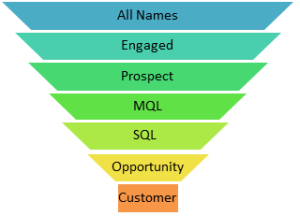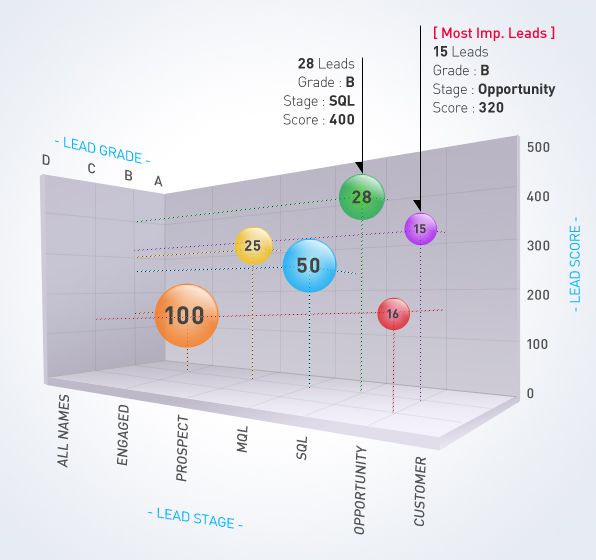“Things which matter most must never be at the mercy of things which matter least.”
– Johann Wolfgang von Goethe
In sales & marketing, the most important discipline is to stay focused on Leads that matter most. It is, of course, important to nurture leads so that they start mattering. That’s the art and science of Lead Nurturing and we will not talk about it in this article.
This article will help you in determining Leads that matter most. It will help answer questions like these:
- How do you know which Leads within your lead database of 50,000 have to be engaged this week?
- In addition, what methods of engagement are going to help make them sales ready?
The answer lies in knowing the “Lead Pulse”. Lead Pulse provides a 3-dimensional view of a Lead that can help determine whether and how to engage a Lead.
The three dimensions of Lead Pulse are:
- Lead Score – a measure of Lead activity in response to your marketing offers
- Lead Stage – a measure of relative positioning of Lead in the marketing funnel
- Lead Grade – a measure of fitment of the lead with ideal customer profile
Lead Score
An engaged Lead will surely interact with you – online or offline. These interactions are essentially Lead activities with varied level of importance. For example, an Email Open event is important but not as important as submission on Landing Page. We need to capture both – but assign different weights or scores. To compare two Leads, we need to aggregate all activity scores in a given timeframe. This aggregated score is Lead Score.
Lead Score will tell you which leads have been relatively more active than others in a given time frame. The change (or delta) in Lead Score in a given time period (like day, week, month) is the measure of its activity.
The most important aspect of Lead Scoring is the weight you assign to each activity. It should reflect how you want to differentiate the importance of activities that happen in lead lifecycle.
Example: You may configure LeadSquared with following Lead Scores:
| Email Open | 02 |
| Email Link Click | 05 |
| Webpage Visit | 02 |
| Landing Page Visit | 05 |
| Landing Page Submission | 10 |
| Phone Call | 20 |
You have a new offer; you do an Email Campaign on it. One of the recipients (or Lead) – Dave opens the emails, clicks two links in it, comes to your Landing Page and submits. This all happens in few minutes. His Lead Score is 2+5*2+5+10=27.
Another recipient – Kim – opens the Emails but does not do anything immediately. She comes to your webpage later, visits Landing Page but does not submit. She calls after 2 days. Her Lead Score is 2+2+5+20=29.
Both Leads are important for you but since you configured Phone Call with the weight 20, Kim gets a better Lead Score than Dave and she should be pursued first.
Lead Stage
Leads may be at different levels of engagement with your offers depending upon their awareness, need, interest and budget. The position of a Lead in marketing funnel based on its level of engagement is called Lead Stage. You can group Leads into different stages based on their similarity or disparity in their level of engagement. The advantage of this grouping is that you can customize your method of Lead engagement and your offers for each Lead Stage.
As Lead progress from being a mere contact to customer, it transitions several intermediate stages. This transitioning of large collection of Leads typically forms a shape of a funnel like the one below.

Names or All-Names
This is the stage where Lead is part of all possible contacts that may collectively represent your universe of target
Engaged
A Lead that is paying attention to your marketing methods and offers is called Engaged. For example, a Lead that is opening your emails and clicking links.
Prospect
A prospect is any engaged Lead who may be in need of goods or services that your company offers.
Marketing Qualified Lead (MQL)
It represents a Lead that has been explicitly qualified by marketing team based on the level of engagement with the lead. For example, a Lead that has responded to an Email Campaign or submitted its details on a Landing Page could be classified as MQL.
Sales Qualified Lead (SQL)
Marketing team typically hands over the MQL leads to sales team. When sales team engages with the Lead (typically through a phone or in person meeting) and qualifies it to be good enough to be pursued then it moves to the SQL stage.
Opportunity
A Lead moves into Opportunity stage when it qualifies the Budget, Authority, Need, Timeline (BANT) criteria:
- Budget: The Lead has budget to buy your goods or services
- Authority: The Lead has authority to buy
- Need: Lead is in definite need of your goods or services
- Timeline: There is a defined timeline to buy
Customer
When a Lead eventually buys your goods or services, it becomes a Customer.
Example of Lead Stages from Tech Industry
You can configure Lead Stages based on how you want to track the progress of lead in sales cycle. We have captured lead stages for Tech Industry to give you some ideas.
Independent Software Vendors (ISV):

IT Consulting Companies:

Lead Grade
Lead Grade is a measure of fitment of the Lead with your Ideal Customer Profile (ICP). It tells you how close the Lead is to ideal customer that you want to sign-up. It is important to define ICP clearly in order to do effective grading. Here is an example of ICP for a company selling software product or services to distributors and resellers of consumer electronics:
| ICP qualification criteria | Example |
| Customer Revenue | More than 100 M USD |
| # of Employees | More than 500 |
| % spend on R & D | More than 5% of Revenue |
| % spend on Software Maintenance | More than 10% of revenue |
| Industry | Electronics |
| Customer Type | Distributors & Resellers only |
| Customer Geography | Japan, Korea and China |
| B2B or B2C | B2B only |
| Technology Alignment | Java & Open Source |
| Business Software | SAP ERP, SalesForce CRM |
| Certifications | ISO 9001:2010 |
You can group Leads based on their level of fitment with the ICP and apply differentiated marketing methods and efforts in each of the group. These groups are known as Lead Grades. A sample Lead grading scheme that is commonly used is:
| Lead Grade | Definition |
| A | The Lead very closely matches the ICP. It passes more than 90% of the lead qualification criteria |
| B | The Lead matches the ICP on more than 75% of the lead qualification criteria |
| C | The Lead matches the ICP on more than 50% of the lead qualification criteria |
| D | The Lead matches the ICP on less than 50% of the lead qualification criteria |
The marketing efforts will normally be focused on Lead Grade A and B since they are close to the ICP. The Leads with grade C & D may need a different type of offer and they should be engaged only if you decide to create such an offer.
How to read Lead Pulse
Lead Pulse is a snapshot of Lead Score, Grade and Stage at any given point of time. The snapshot helps you in prioritizing your attention to the Leads.

Normally, Lead Score, Stage and Grade do not have equal importance or weight in determining Lead Pulse.
- Lead Stage is most important for a business since the deeper the Lead is in the funnel the better is probability of conversion. For example, a lead with grade “A” and top score but in stage “Engaged” will be less important than Lead in grade “B” with low score but in stage “Opportunity”.
- Then comes Lead Grade. A business will usually want to focus on Leads that closely match their ICP. For example, a Lead with grade D may be very active and thus have a very high lead score but will not be worth pursuing because it may be far from your ICP. You may not want that lead as customer.
- Lead Score should be looked at once Lead Stage and Lead Grade thresholds are qualified. Among the Leads having same grade and stage, Lead Score will determine which lead has a higher pulse and thus should be pursued first.
There is no standard formula for Lead Pulse that fits all situations. Each company needs to define the rules containing thresholds of Lead Score, Stage and Grade that will trigger certain actions. These thresholds may change based on changing business priorities.










![[Webinar] Sales Automation 101: Unclog your Sales Pipeline](https://www.leadsquared.com/wp-content/uploads/2024/04/automation-webianr-popup.gif)